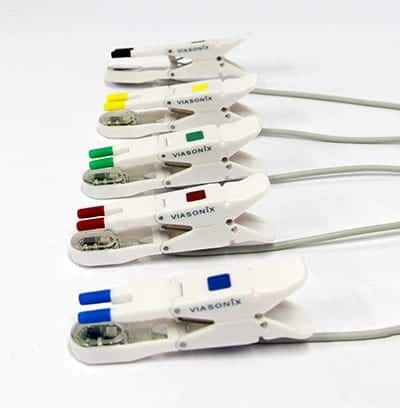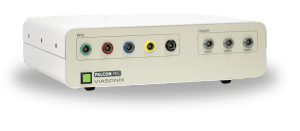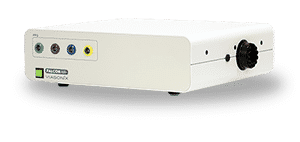What is Stress Test?
Physiological examinations repeated after induced stress, typically following a specific exercise protocol, are used to differentiate between vascular disorders and determine the functional severity of stenosis. This test is particularly recommended with a borderline ABI.

An asymptomatic arterial lesion in the lower limbs may become symptomatic after induced stress.
The purpose of the exercise testing is to increase the blood flow in the legs, which in turn may result in a more considerable pressure drop distal to an arterial lesion or obstruction to flow. In this situation, the ABI (Ankle Brachial Index) will decrease post-stress testing compared to the ABI value at rest.
How to Perform Exercise Stress Test
The induced stress protocol is usually standard and well defined, with 5 minutes of walking on a treadmill at a pace of 2 mph and at an inclination grade of 10-12 degrees, or until the patient experiences pain. Alternatively, tiptoeing or similar exercise activity may be used to induce stress.
All exercise activities must be under the supervision of the examiner. Special caution should be taken prior to deciding to perform exercise tests. There are several contraindication risk factors that should prevent from performing this test, including:
- ABI less than 0.5 or greater than 1.3,
- Chest pain or unstable cardiac status,
- Hypertension,
- Breath issues, or
- Unsteadiness when walking.
Most frequently, the stress testing will include measurements of ABI or Segmental Blood Pressures, but Pulse Volume Recording (PVR) and CW Doppler measurements are also common. Segmental pressures are often measured at different post-stress times to determine the recovery time from the stress effects. Particular interest is in identifying significant variants from the resting pressure indices and, specifically, changes in the ABI.

Doppler Probes
Gold Standard ABI Measurement Method

PPG Sensors
Secondary Method of ABI Assessment

Inflatable Cuffs
High quality available in a variety of sizes
Using the Falcon for Stress Testing
The Falcon supports stress testing following exercise with a variety of measurements, including blood pressure measurements and ABI, and Doppler, PVR, and PPG measurements. A protocol list clearly details all of the sites that were measured under rest conditions prior to exercise and marks the corresponding pressures in a graphical manner for clarity.
Furthermore, the Falcon allows an unlimited number of measurement cycles after the induced stress in order to quantify the time to recovery in a controlled manner.
The Falcon also has an easy option of adding Stress Testing “on the fly” to any examination protocol with a single button, even if this test was not previously configured or planned. This feature allows optimal clinical diagnosis when Peripheral Arterial Disease (PAD) is suspected.
The details and documentation of the induced stress are well defined. A selection is available to define the type of induced stress, such as Exercise, Cold Immersion (particularly for Raynaud’s testing), or Reactive Hyperemia (in exceptional cases when the patient is unable to exercise). All details of the exercise test are also documented, including the type of exercise and speed and inclination of the treadmill. In addition, a large digital timer displays the progress of the induced stress, the onset of symptoms during the exercise can be easily inserted, and the total duration of stress is also documented.
The Rest control measurement can be displayed on the screen while performing the Post-Stress measurement for comparison and clear clinical assessment. In addition, charts and graphical bars display the pre- and post-stress pressures for each measured site, including the corresponding pressure differences.
User configured alerts can define those threshold conditions that highlight the sites with clinically significant pressure drops for optimal clinical diagnosis.
Expected Results
It is expected that with a significant arterial lesion, the distal pressures and the corresponding ABI value will decrease after exercise. Severe PAD is considered when the post-exercise ankle pressure drops by more than 20 mmHg. Likewise, a decrease in the value of ABI by more than 0.2 also indicates PAD.
The recovery time of the ankle pressures to baseline values after exercise is usually within 2 minutes.
Longer periods of recovery time indicate different levels of disease, such as single or multi-segment disease or resting pain, when recovery time is longer than 15 minutes.
Selected Literature
Overview of Peripheral Arterial Disease of the Lower Extremity, Ali F. AbuRahma and John E. Campbell, Noninvasive Vascular Diagnosis, A.F. AbuRahma (ed.), Springer International Publishing AG 2017, Ch 21, pp 291-318
2016 AHA/ACC Guideline on the Management of Patients With Lower Extremity Peripheral Artery Disease; A Report of the American College of Cardiology/American Heart Association Task Force on Clinical Practice Guidelines; Journal of the American College of Cardiology, Vol. 69, No. 11, 2017
2017 ESC Guidelines on the Diagnosis and Treatment of Peripheral Arterial Diseases, in collaboration with the European Society for Vascular Surgery (ESVS), Victor Aboyans et al., European Heart Journal (2017) 00, 1–60
Noninvasive Physiologic Vascular Studies: A Guide to Diagnosing Peripheral Arterial Disease, Robert C. Sibley et al., RG • Volume 37 Number 1, pp 352-355
Peripheral vascular disease assessment in the lower limb: a review of current and emerging non‑invasive diagnostic methods; Shabani Varaki et al, BioMed Eng OnLine (2018) 17:61
Nonimaging Physiologic Tests for Assessment of Lower Extremity Arterial Disease, Marsha M. Neumyer, in “Introduction to Vascular Ultrasonography”, Ed. Pellerito and Polak, Elsevier Health Sciences, 2012, Ch 14, pp 244-261
Disclaimer of Information & Content
The content of Viasonix Ltd. website is for information only, not advice or guarantee of outcome. Information is gathered and shared from reputable sources; however, Viasonix Ltd. Management is not responsible for errors or omissions in reporting or explanation. No individuals, including those under our active care, should use the information, resources or tools contained within this self-diagnosis or self-treat any health-related condition. Viasonix Ltd. Management gives no assurance or warranty regarding the accuracy, timeliness or applicability or the content.








